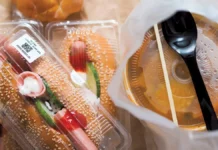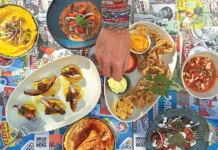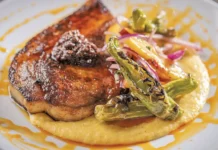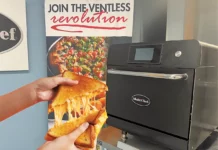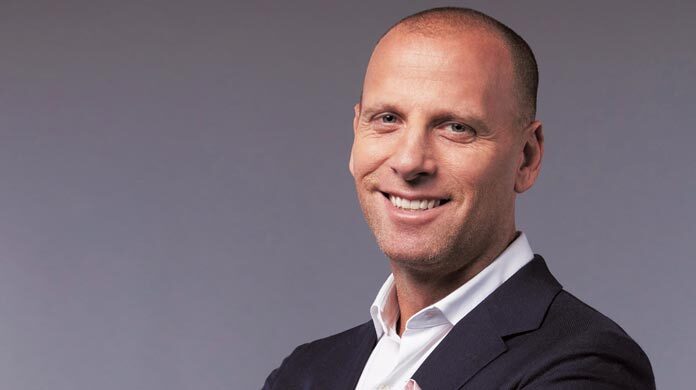
Total Food Service is always on the lookout for interesting stories that define the Metro New York restaurant industry. A key to that strategy is identifying who is “next”. After all, our mission is to provide our readers with the latest news on all the happenings within the industry, in addition to profiling prominent figures.
One such figure is Michael Schulson, a celebrity chef and successful restaurateur. As the founder of the Schulson Collective, he’s come a long way from his humble beginnings working in a pizza joint on Long Island after he dropped out of college. Schulson’s company has morphed into a regional power.
The portfolio of restaurants in Philadelphia, Atlantic City, and South Florida includes Double Knot, Izakaya, the Graffiti Bar, Sampan, Harp & Crown, the Independence Beer Garden, Monkitail at The Diplomat Beach Resort, Giuseppe & Sons, and most recently, Alpen Rose. Michael Schulson shared insight into his background, work ethic and plans on expanding to New York City.
Tell us a little bit about your background and what got you interested in cooking?
I grew up on Long Island in Roslyn Heights. I was always around food. My grandmother used to cook and it really intrigued me. I mean I remember my brother making fun of me when we were outside playing sports and my grandmother would come in and be like, “Michael, Michael you want to help us make some soup,” or whatever, and I was so excited to do it. At first, I was really intrigued by the concept of going to school for architectural engineering because my uncle was a very successful developer in Rockland County. So I just graduated high school went to school for architectural engineering for two years and decided this is not for me whatsoever because I wasn’t being creative enough. I dropped out and moved back home. But since my parents were teachers, they kind of looked at me and told me I needed a job if I’m going to drop out of school. So I went back to school, saw a bulletin board and pulled off one of the pieces of paper that said a pizza place was looking for somebody to make the pizzas. The rest is kind of history.
What did you take from humble beginnings at a Long Island pizza shop?
I worked in that pizza place for about a year. The owner said to me that if I was going to do this as a career that I should probably go to cooking school. This was probably 26 years ago now.
How did you decide on where to go to school?
There was no Food Network really, very limited cooking shows. Cooking wasn’t sexy by any chance… it wasn’t cool. I didn’t know where to go to school and the pizza shop owner suggested I check out the Culinary Institute of America (CIA). Back in the day there used to be prerequisites. One was a year in food and beverage (but you could lie) and a six-month waiting list. I got in and went to school and I just kind of fell in love with it. It was hands on, interactive, creative learning. I remember coming home to my parents – and they still tell me the story to this day – and I said, “you know what, mom and dad, it’s amazing.” I didn’t realize I could actually learn something at school. That was it. The rest is history.
What did the career path look like after the CIA?
Every chef has this dream of opening their own restaurant, cooking their own food and doing their own thing and I was no different. I went down that path and worked at many places, including the Waldorf Astoria and Peacock Alley and a number of fine dining and smaller restaurants. Then I started working in some bigger restaurants and my horizons broadened. I always loved math, so I was intrigued by a restaurant’s P&L. I would sit down with the owner and they would ask me questions I could comfortably dissect.
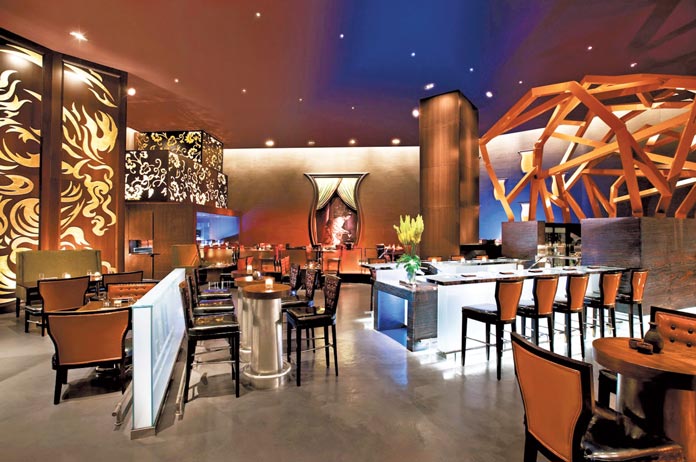
The Borgata has had a big impact on your career on several occasions.
As I started to grow and work with different people and different restaurants, the Borgata heard about me. They brought me down and they introduced me to Bobby Flay and Wolfgang Puck. They said you could be a part of this team and I was like, “Wow that’s a pretty good team to be a part of. Sign me up!” So I did that deal and while growing at the Borgata, I started to meet business people that would have a big impact on my life in Philadelphia. Those relationships spurred not just my interest in restaurants but in business in general. I really became a student of business and studied and read about it and discussed with my friends. I wanted to know how do you set up these business deals and what do they look like. I became curious about when a deal became bankable, how debt and equity worked or are you just raising capital?
So I had a bunch of guys that were like, “We’ll give you a couple thousand dollars. Why don’t we open a restaurant?” And that was 10 years ago and since then we’ve been able to move our company to 11 restaurants. We have our 12th, 13th and 14th opening by the end of this year. We are still on an amazing growth pace.
So how did restaurant one turn into restaurant two? And was that a tough jump?
So that was obviously a big concern of my business partners. They were asking where my time would be focused, but they took a chance on me. When we first opened, I was in the office reading Quick Books for Dummies. I had my accountant coming in and teaching me Quick Books and I was literally doing all of it. I remember I didn’t take a salary for the first five months and I was making sure that I was paying back investors because I didn’t want to have bank debt. Then something clicked and the restaurant just took off, the area got busier and we got more consistent. And then we turned it into the next restaurant and then we turned it into the next, and the guys got very concerned and they worried I was no longer the chef and asked, what happens now? I think the advantage that I had and what allowed that to happen was while we were struggling at Sampan, I was the one doing the books.
So to me all of a sudden at that point, when I had the third restaurant, I was like, “Wow this business thing is almost as exciting in some ways as restaurants.” Like I just love and I’m fascinated with this concept of how are we going to build the company.
So what’s your approach to building a team?
The most important thing with building a team is my involvement. Leading by example is the only way that you can. I mean we just did a little bit of a restructuring, with my wife filling in as the COO role and we moved her over to the Chief Marketing Officer. We created the gap almost between me, as the CEO, and the rest of my directors of operation and restaurants, so this way they all report directly to me because that’s what this business is built on; it’s built on hospitality and service and all of that. So they report directly to me and the org chart is probably the key to our success at this point.
So when we talk to you, why do we sense such calmness? We don’t hear any ego.
My wife laughs at me, but we have an amazing team. Many people say greed conquers all. I mean, I don’t believe that. To me, it’s ego that conquers all. I mean are we cooking the food that I want to cook at every single restaurant every single day? No, we’re cooking the food that the people want. It’s not about what I want; it’s about what the people want. So to me, it’s about having a really good group of business partners that I could count on, rely on, ask questions and grow with.
For the first time you expanded outside to a place you can’t drive to anymore with Florida. How does the change in the footprint change how you run your business?
It definitely does. When I’m down there, I tell my staff that just because I’m in Florida doesn’t mean we stop communicating. And to me that’s kind of the key if we’re doing more stuff. I mean Florida is hard for us right now because we have one restaurant. We’re looking in Delray we’re looking in Brickell and we’re looking in Palm Beach. So if we could grow that for four restaurants, all of a sudden we could afford to have a director down there and we could have a bookkeeper down there as well as have a salesperson down there. And then all of a sudden we have an infrastructure that makes sense. Which definitely makes our life a lot easier.
Tell us a little bit about Giuseppe and Sons. Where did this idea come from?
We were presented with a huge space in Philadelphia in a basement, 14,000 square feet and another 2000 square feet upstairs. Our belief in restaurants is three fold: one is their design, two is service and three is food. And when we build something, we believe that the most important element is the design. And this is coming from a chef – keep in mind. So that’s how we start. With Giuseppe’s, we got this amazing space in a basement and hired Home Studio, which is out of Brooklyn (great designers). And my wife grew up in a very hardcore Italian family here in Philadelphia, so to us, it’s kind of paying homage to what she grew up eating. So that’s what we do there… It’s southern Italian food that’s not really heavy; you don’t feel gluttonous and like you were a pig when you walked out of there – all in a beautifully well-designed space. The range of entrees is mostly around $16 to $22, really accessible. So we’re finding that people are coming in two to three times a week. The upstairs concept is a sandwich shop during the day. So you walk in upstairs and you have a variety of sandwich options.
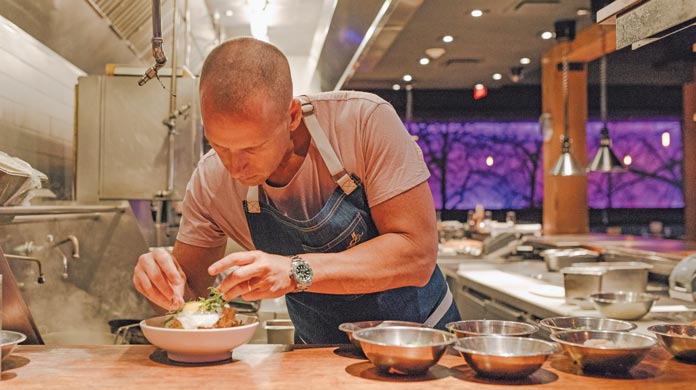
The theme of what I hear from you is that you read the neighborhood. You read the customer base and then you deliver a product that’s going to solve those needs.
Again, it’s not about what I want to create. It’s about what is needed in the neighborhood. And I think a lot of people miss that from a business standpoint. It’s okay to want to open up a French Bistro, but when there’s three French Bistros in a neighborhood, so there’s no density. I tell my business partners that I need to go to a place where I can get business people, I could get tours, I could get locals, and I can get convention people as well. We need all those customer segments if I’m going to make it work.
Is that why you aren’t in New York yet?
We’re looking in New York. We have a name in Philly, obviously and in New York, we don’t. Most of the spaces listed in New York, people have already pitched them to us and there’s a reason why it’s not taken. So the struggle for us is having good spaces call us back. We’re trying to find the right space without having the brand recognition in New York.
Did Hudson Yards call you?
Yes, they did. But for us, I think it was just about location and our first entry into New York. We didn’t want to be in that location and there’s this big sense of how many restaurants are going in there? 15…30? That’s not our kind of model. And I also believe the most important demographic is locals and it’s not really local yet.
Are you excited to move outside of Philly?
We’re definitely excited. I mean we’re definitely looking in Florida, and are definitely looking in New York. Also in D.C. and other concepts we’re thinking of for fast casual options that would go great in most college towns. We’ve also had a bunch of people approach us about managing, but we don’t want that because we have enough infrastructure to be able to do things that most people who do management deals can’t do.
We also hear that you invest in small businesses? Where did this come from?
So business partners are awesome and like to do a lot of investing. I told them if they have interesting deals to throw them my way to look at the perspectives and try to diversify my portfolio a bit. We invested in a shoe company called Margaux shoes out of New York. Two fabulous girls, and to me you don’t invest in concepts, you invest in people. My wife loved the shoes and they’re great people, so we invested in that. We also invested in a company called Ownable, which allows you to rent household items with an option to buy it after. We also invested in a healthcare management company. It’s been a lot of fun!
With so much technology now and a huge focus on delivery and takeout and things like that, is that part of your world or not?
I actually have a completely different view than most people have on it. Our mission is to create a beautiful restaurant design that screams fun/energy when you walk in. So we don’t do takeout for any of our restaurants except the sandwich shop in Philly and our fast casual sushi place. We have GrubHub pushing us, Doordash and the like, but we don’t do takeout. My belief is, the way to make money is to put asses in seats in your restaurant. If the place is empty, is it even a cool place anymore? I don’t think so. My belief is, if I walk down the street and check out a restaurant and then go home, if I see that I could order from all these places, I’m less likely to go into that restaurant because I can order that food. Plus, takeout orders can be a headache on top of regular service. I think too many people are forgetting that many people still like to go out!
All photos courtesy of Schulson Collective


















